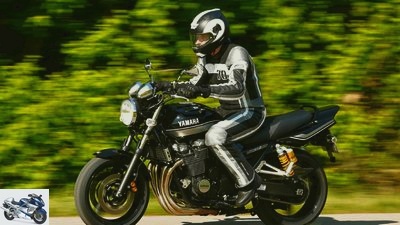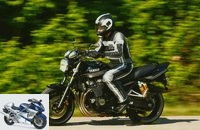Menus
- Japanese big bike with a retro look
- Technical specifications
- The classic from Yamaha for your own home

Driving report: Yamaha XJR 1300
Japanese big bike with a retro look
It has cult status and is practically the last of the Mohicans among the air-cooled Japanese big bikes. A trip on the XJR 1300 makes you wonder: Do you really need these modern, hyperactive power machines??
The rear view is reminiscent of the sports group of the nineties and emphasizes the limited sporty demands of the XJR 1300.
A calming silence. Not a car, not a soul, not a bird twittering far and wide. The break during the evening lap on a bench in the middle of the countryside is a special one this time. Because the silence is interrupted at irregular intervals by noises that are hardly known from modern kettles. This irregular, fine crackling and ticking that occurs when an unevenly heated, air-cooled engine gradually cools down again after a tour, when the tension in its components gradually loosens. A moment of relaxation for the machine – but also for the driver.
Buy complete article

Driving report: Yamaha XJR 1300
Japanese big bike with a retro look
Round instruments and odometer are easy to read.
The last remaining Japanese big bike with an air-cooled four-cylinder exudes its heat in the cool evening air. The Yamaha XJR 1300 is a classic in motorcycle construction. Not because it represents the absolute superlative in any area, because it shows off extremes. But because it embodies history. The XJR has been part of the Yamaha range for 17 years and tells you about the past. Just sit there, look at the motorcycle, listen to the crackling noise in every corner – that’s balm for the soul. Memories of the good old days? Well, definitely not everything was better in the past, but some things might be simpler, more beautiful, more sensual. The Yamaha stands there very puristically, displaying its ribbed engine elegantly in the wind and confidently flaunting the stereo struts. "Look, a motorcycle has to look so simple and clear", you think you can see from the classic round headlight. The Japanese have perfected four air-cooled cylinders in a row, installed transversely. This configuration was the recipe for success for decades and stood for the brilliant technical progress of the motorcycle scene. But today all air-cooled bikes belong on the list of endangered species due to increasingly strict emission and noise regulations.
The big bike glides wonderfully confidently through the landscape. The torque of the engine supports a calm driving style.
When the XJR debuted in 1995 with 1200 cc, the Honda’s CB1000 and Kawasaki’s Zephyr 1100 had long since ushered in the renaissance of classic big bikes. Following the example of the XS 1100 from 1977, Yamaha added a motorcycle that was reduced to the essential features and thus met the taste of tens of thousands. It’s nice that, unlike some of its competitors, Yamaha resisted the temptation to modernize this machine technically and optically. Sure, such concessions as the injection introduced in 2007 and a G-Kat had to be made – but they didn’t hurt either. The timeless design captivates the eyes to this day, embodies the materialized core of motorcycling. The puristic design language, paired with a 1,300 cubic centimeter muscle man who diligently shovels torque to the crankshaft. That inspires – regardless of whether the driver is looking at the motorcycle or sitting on the comfortable seat.
So, made enough break and philosophized. The starter must make an audible effort to restart the cooled engine. The fat row four spoils after driving off with a silky smooth run – but only up to 3000 revolutions. High-frequency vibrations are transmitted via the handlebar ends and footrests, especially when pushing, which penetrate the rider’s body unfiltered. Madness, how it tingles! Are these the good vibes of the 1970s? At least the pistons with a 79 bore leave no doubt about their potency and want to be treated with respect. The bearish cubic capacity is underlined by the four-in-one system, which hisses decently at low speeds and screeches magnificently at higher strokes. Not an unpleasant riot, but a clear announcement for today’s noise regulations.
Good Vibes – the air-feeling four-cylinder four-stroke in-line engine
Almost like in the past, one could add and take a look back at history. Sure, silencers were previously allowed to have less volume, the current XJR pot is somewhat reminiscent of a stovepipe. After all, with its rough, shiny surface structure, it is first-class processed. The classic charm of this bike also includes ergonomics that no longer seem completely up to date. On longer stages, the upright sitting position is exhausting due to the high, only slightly cranked handlebars. In combination with the knee angle that is reminiscent of athletes, the posture does not look particularly harmonious. On the other hand, the good overview gives the driver a certain aplomb. You can feel that this motorcycle is well received everywhere, attracts attention and fascinates. Many finely crafted details contribute to this. Even such mundane things as the motor mounts on the steel double loop frame are pretty and valuable. Details that you enjoy.
You can understand a certain pride of ownership among XJR drivers. Good for the ego, but it also makes you relaxed. A sovereignty that eludes the hectic striving for the better, for example for more performance or less weight. This machine is heavy, namely a whopping 251 kilograms – and that’s a good thing. You can literally see the kilos, and you can feel them. Here the driver still has to work properly on the handlebars in order to fold the run from one side to the other. This motorcycle definitely doesn’t seduce you to race. Better to be on the penultimate than the last one, gliding gently through the landscape, picking up the road quickly, but with pleasure. Let the others race. Brisk pace is by no means forbidden, the motorcycle lies surprisingly well on the asphalt despite the old Dunlop Sportmax D252. But for the country road hunt, the XJR wants to be directed pretty hard, does not hide its pounds with a sharp steering geometry.
The stereo struts are fully adjustable and do a very good job.
But hey, who really cares? After all, the 1300 is a big bike and wants to be perceived as such. Oops, a moment with your thoughts elsewhere, and suddenly a tractor crosses the road. The R1 pliers bite into the panes not too weakly, but not too poisonous either. With a clear pressure point and good controllability, excellent deceleration performance is included, nonetheless, ABS would be at the top of the wish list for the next evolutionary stage. But will there be a sequel? If you get involved with the peculiarities of the Yamaha, try to understand its essence and accept its retrospective modernity, then it is a soul flatterer, a driving pleasure object. Calm and serenity, yet sovereignty and a lot of torque: these are features that make them unique. Imagine this motorcycle without cooling fins, but with a wide water cooler placed in front of the bow. That would be the willful destruction of a work of art. The Yamaha par excellence shows how senseless motorcycling can be. It embodies the classic interpretation of a big bike not only in terms of its design, but also of its character. Hopefully she will be able to accompany us a little more in the future. Otherwise it would be a shame – and not just about the cozy crackling after the end of the day.
Technical specifications
The last remaining Japanese bike with an air-cooled four-cylinder.
engine
air-cooled four-cylinder four-stroke in-line engine, dohc, bore x stroke 79.0 x 63.8 mm, 1251 cm³, 72.0 kW (98 PS) at 8000 / min, 108 Nm at 6000 / min, injection, Ø 34 mm, E-starter, five-speed gearbox, O-ring chain.
landing gear
Double loop frame made of steel, telescopic fork, Ø 43 mm, two-arm swing arm made of aluminum, two spring struts, double disc brake at the front, Ø 298 mm, disc brake at the rear, Ø 267 mm, tires 120/70 17; 180/55 17.
mass and weight
Wheelbase 1500 mm, steering head angle 64.5 degrees, caster 100 mm, suspension travel f / r 130/120 mm, seat height * 800 mm, weight with a full tank * 251 kg, load * 199 kg, tank capacity 21.0 liters.
Price: 11250 euros (excluding additional costs)
The classic from Yamaha for your own home
Used Yamaha XJR 1300
To be able to call the puristic bike your own, you don’t have to overcome many hurdles. Maybe your own wife. The price is definitely not a hurdle. The Yamaha XJR 1300 is available on the used motorcycle exchange in good condition and very cheap: Used Yamaha XJR 1300 in Germany
http://bit.ly/Gebrauchte_Yamaha_XJR_1300
Related articles
-
Euro 3 classic: Yamaha XJR 1300
factstudio.de 13 pictures factstudio.de 1/13 Yamaha XJR 1300. factstudio.de 2/13 Yamaha XJR 1300. factstudio.de 3/13 Yamaha XJR 1300. factstudio.de 4/13 …
-
Yamaha XJR 1300 in the PS driving report
5 pictures 1/5 … the fine dials of analog clocks. 2/5 With a new look in the trendy cafe racer look …
-
BMW R nineT, Moto Guzzi Griso 1200, Yamaha XJR 1300 and Honda CB 1100 in comparison
www. 38 pictures www. 1/38 What an eerie attraction the BMW R nineT, Moto Guzzi Griso, Yamaha XJR 1300 and Honda CB 1100 …
-
Test Yamaha XVS 1100 Drag Star
Test Yamaha XVS 1100 Drag Star Moby Quick Cruisers are overweight, poorly motorized and have lousy chassis, according to popular opinion. Lives…
-
Honda CB 1100 RS, Kawasaki Z 900 RS and Yamaha XSR 900 in the test
bilski-fotografie.de 31 photos bilski-fotografie.de 1/31 The Honda CB 1100 RS. bilski-fotografie.de 2/31 A feast for the eyes: Visually, the Honda is…
-
Photos: fact Test: Honda VT 1300 CX Honda’s custom bike: the Honda VT 1300 CX What is this now? While Honda’s new and only custom bike bears the nickname…
-
37 pictures 1/37 King of the Hills: We ride the classic mountain race tracks on classic looking bikes. 2/37 …
-
Yamaha XJ 650, XJ 650 Turbo and XJ 900 F in comparison test
Bilski comparison test Yamaha XJ 650 / XJ 650 Turbo / XJ 900 F four-cylinder Yamahas in comparison test Contents of Yamaha’s XJ series are still considered …
-
Yamaha MT-09 Tracer in the top test
Bilski 32 pictures Bilski 1/32 Yamaha MT-09 Tracer. Manufacturer 2/32 Competition: MV Agusta Stradale. Manufacturer 3/32 Competition: Triumph Tiger 800 XR ….
-
Honda CBR 650 F, Suzuki GSX 650 F, Yamaha XJ6 Diversion F in the test
fact 46 photos fact 1/46 The Suzuki as a solid all-rounder, the Yamaha as a lively fun bike. Honda is changing the CB 650 F with the casing, on the other…